1997 CHEVROLET ASTRO heating
[x] Cancel search: heatingPage 86 of 404
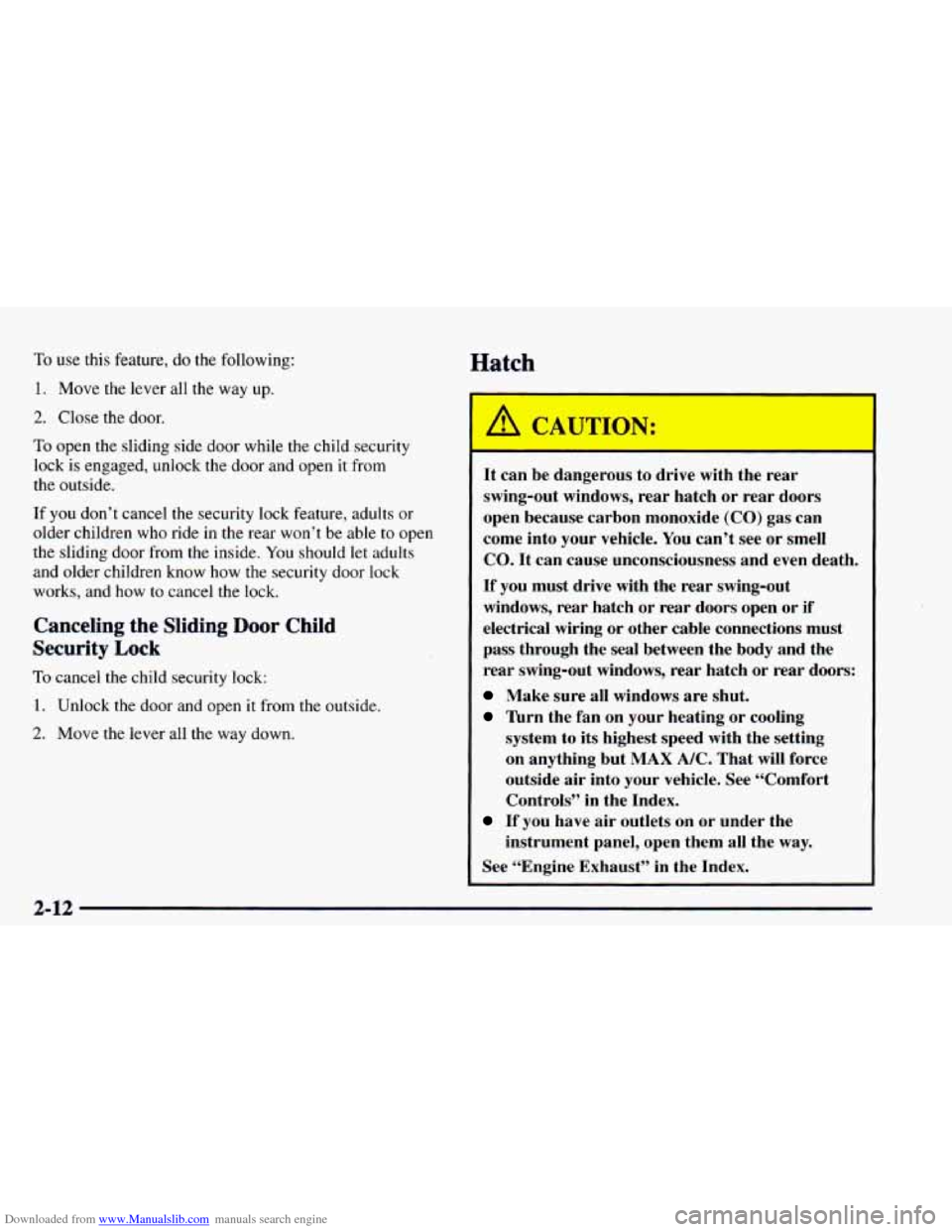
Downloaded from www.Manualslib.com manuals search engine To use this feature, do the following:
1. Move the lever all the way up.
2. Close the door.
To open the sliding side door while the child security
lock is engaged, unlock the door and open it from
the outside.
If you don’t cancel the security lock feature, adults or
older children who ride
in the rear won’t be able to open
the sliding door from the inside. You should let adults
and older children know how the security door lock
works, and how to cancel the lock.
Canceling the Sliding Door Child
Security Lock
To cancel the child security lock:
1. Unlock the door and open it from the outside.
2. Move the lever all the way down.
Hatch
It can be danL ‘ous to drive with the rear
swing-out windows, rear hatch or rear doors
open because carbon monoxide (CO) gas can
come into your vehicle. You can’t see or smell
CO. It can cause unconsciousness and even death
If you must drive with the rear swing-out
windows, rear hatch or rear doors open or if
electrical wiring or other cable connections must
pass through the seal between the body and the
rear swing-out windows,
rear hatch or rear doors:
Make sure all windows are shut.
Turn the fan on your heating or cooling
system to its highest speed with the setting
on anything but MAX A/C. That will force
outside air into your vehicle. See “Comfort
Controls” in the Index.
instrument panel, open them
all the way.
If you have air outlets on or under the
See “Engine Exhaust” in the Index.
2-12
Page 104 of 404
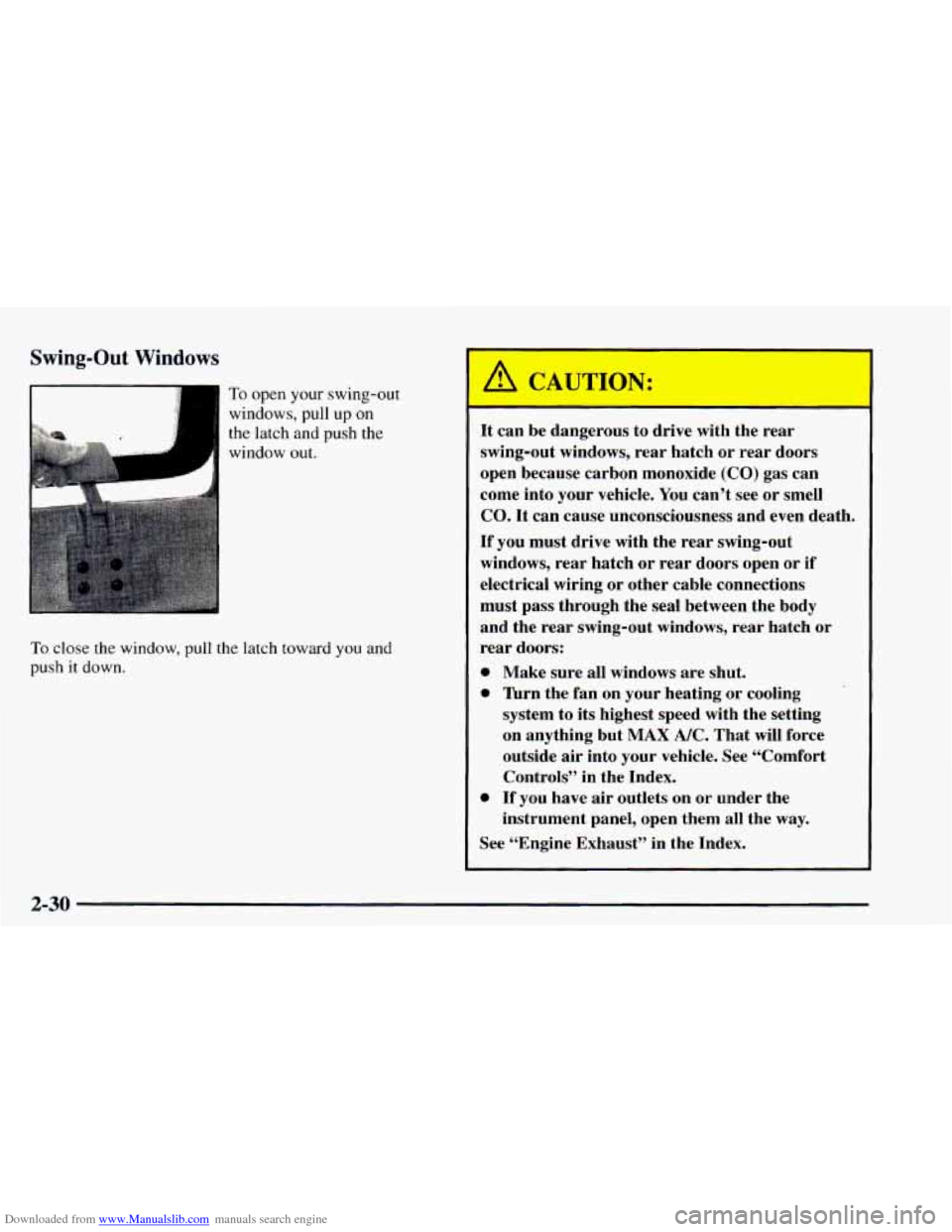
Downloaded from www.Manualslib.com manuals search engine Swing-Out Windows
To open your swing-out
windows, pull up on
the latch and push the
window out.
To close the window, pull the latch toward you and
push it down. It can be dangerous to drive with the rear
swing-out
windows, rear hatch or rear doors
open because carbon monoxide (CO) gas can
come into your vehicle. You can’t see or smell
CO. It can cause unconsciousness and even death,
If you must drive with the rear swing-out
windows, rear hatch or rear doors open or if
electrical wiring
or other cable connections
must pass through the seal between the body and the rear swing-out windows, rear hatch
or
rear doors:
0
e
0
Make sure all windows are shut.
Turn the fan on your heating or cooling
system to its highest speed with the setting
on anything but MAX A/C. That will force
outside air into your vehicle. See “Comfort
Controls” in the Index.
If you have air outlets on or under the
instrument panel, open them
all the way.
See “Engine Exhaust” in the Index.
2-30
Page 124 of 404

Downloaded from www.Manualslib.com manuals search engine ~~ NOTICE:
Loading cargo that
weighs more than 200 lbs.
(91 kg) on the luggage carrier may damage your
vehicle. When you carry large things, never let
them hang over the rear or the sides of your
vehicle. Load your cargo
so that it rests on the
slats and does not scratch or damage the vehicle.
Put the cargo against the side rails and fasten it
securely to the luggage carrier. Put the main
weight as far forward
as you can.
Don’t exceed
the maximum vehicle capacity when
loading your vehicle. For more information on vehicle
capacity and loading, see “Loading Your Vehicle”
in
the Index.
To prevent damage or loss of cargo as you’re driving,
check now and
then to make sure the luggage carrier and
cargo are still securely fastened.
Ashtrays and Cigarette Lighter
The cigarette lighter is on the left of the engine
cover console.
To use the lighter, press it in all the way and let go.
When it’s done heating, it will pop back by itself.
NOTICE:
Don’t hold a cigarette lighter in with your hand
while it is heating.
If you do, it won’t be able to
back
away from the heating element when it’s
ready. That can make it overheat, damaging the
lighter and the heating element.
2-50
Page 138 of 404

Downloaded from www.Manualslib.com manuals search engine Anti-Lock Brake System Warning Light
ANTI -
LOCK
With the anti-lock brake
system, this light will
come
on when you start
your engine and may stay
on for several seconds.
That’s normal.
Engine Co ~ ant Temperature Gage
If the gage pointer moves
to the red area, your engine
is
too hot!
If the light stays on, or comes on when you’re driving,
your vehicle needs service. If the regular brake system
warning lightisn’t on,
you still have brakes, but you
don’t have anti-lock brakes.
If the regular brake system
warning light is
also on, you don’t have anti-lock brakes
and there’s a problem with your regular brakes. See
“Brake System Warning Light” earlier in this section.
The anti-lock brake system warning light should come
on briefly when you turn the ignition key to RUN. If the
light doesn’t come
on then, have it fixed so it will be
ready to warn you if there
is a problem. It
means that your engine coolant has overheated.
If you
have been operating your vehicle under normal driving
conditions, you should pull
off the road, stop your
vehicle and turn
off the engine as soon as possible.
In “Problems on
the Road,” this manual shows you what
to
do. See “Engine Overheating” in the Index.
2-64
Page 147 of 404

Downloaded from www.Manualslib.com manuals search engine Section 3 Comfort Controls and Audio Systems
In this section, you’ll find out how to operate the comfort control and audio systems offered with your vehicle. Be
sure to read about
the particular systems supplied with your vehicle.
3-2 3-2
3-3 3
-4
3 -5
3-5
3-6
3-6
3-6 3-8
3-9
3-9
3-9
3 -9 Comfort Controls
Heating/Air Conditioning System
Heating System
Rear Heating System (Option) Rear Air Conditioning System (Option)
Air Conditioning
Heating
Defrosting
Ventilation System
Rear Window Defogger (Option)
Audio Systems
Setting the Clock for Systems without
Automatic Tone Control
Setting the Clock for Systems
with
Automatic Tone Control
AM-FM Stereo 3-1
1
3-13
3-18
3-19
3-24
3-26
3-28
3-28
3-29
3-30
3-30
AM-FM Stereo with Cassette Tape
Player
(If Equipped)
AM-FM Stereo with Cassette Tape and
Automatic Tone Control
(If Equipped)
Rear Seat Audio
(If Equipped)
AM-FM Stereo
with Compact Disc Player and
Automatic Tone Control (If Equipped)
Playing a Compact Disc
in the Single Remote
Disc Player
(If Equipped)
Theft-Deterrent Feature Understanding Radio Reception
Tips About Your Audio System
Care
of Your Cassette Tape Player
Care
of Your Compact Discs
Fixed Mast Antenna
3-1
Page 148 of 404
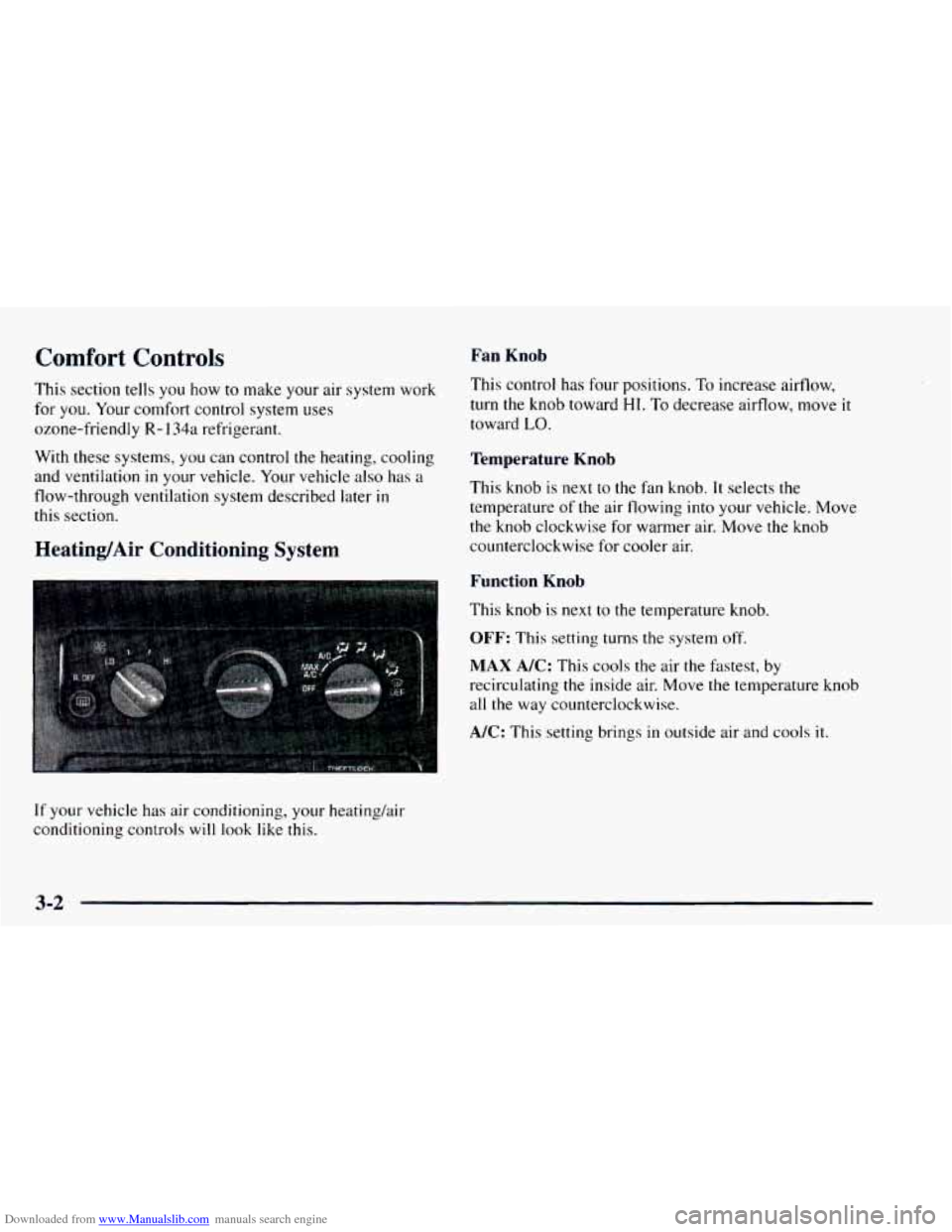
Downloaded from www.Manualslib.com manuals search engine Comfort Controls
This section tells you how to make your air system work
for you. Your comfort control system uses
ozone-friendly
R- 134a refrigerant.
With these systems, you can control the heating, cooling
and ventilation
in your vehicle. Your vehicle also has a
flow-through ventilation system described later
in
this section.
Heating/Air Conditioning System
If your vehicle has air conditioning, your heatinghir
conditioning controls will
look like this.
Fan Knob
This control has four positions. To increase airflow,
turn the knob toward
HI. To decrease airflow, move it
toward LO.
Temperature Knob
This knob is next to the fan knob. It selects the
temperature
of the air flowing into your vehicle. Move
the knob clockwise for warmer air. Move the knob
counterclockwise for cooler air.
Function Knob
This knob is next to the temperature knob.
OFF: This setting turns the system off.
MAX A/C: This cools the air the fastest, by
recirculating the inside air. Move the temperature knob
all the way counterclockwise.
A/C: This setting brings in outside air and cools it.
3-2
Page 149 of 404
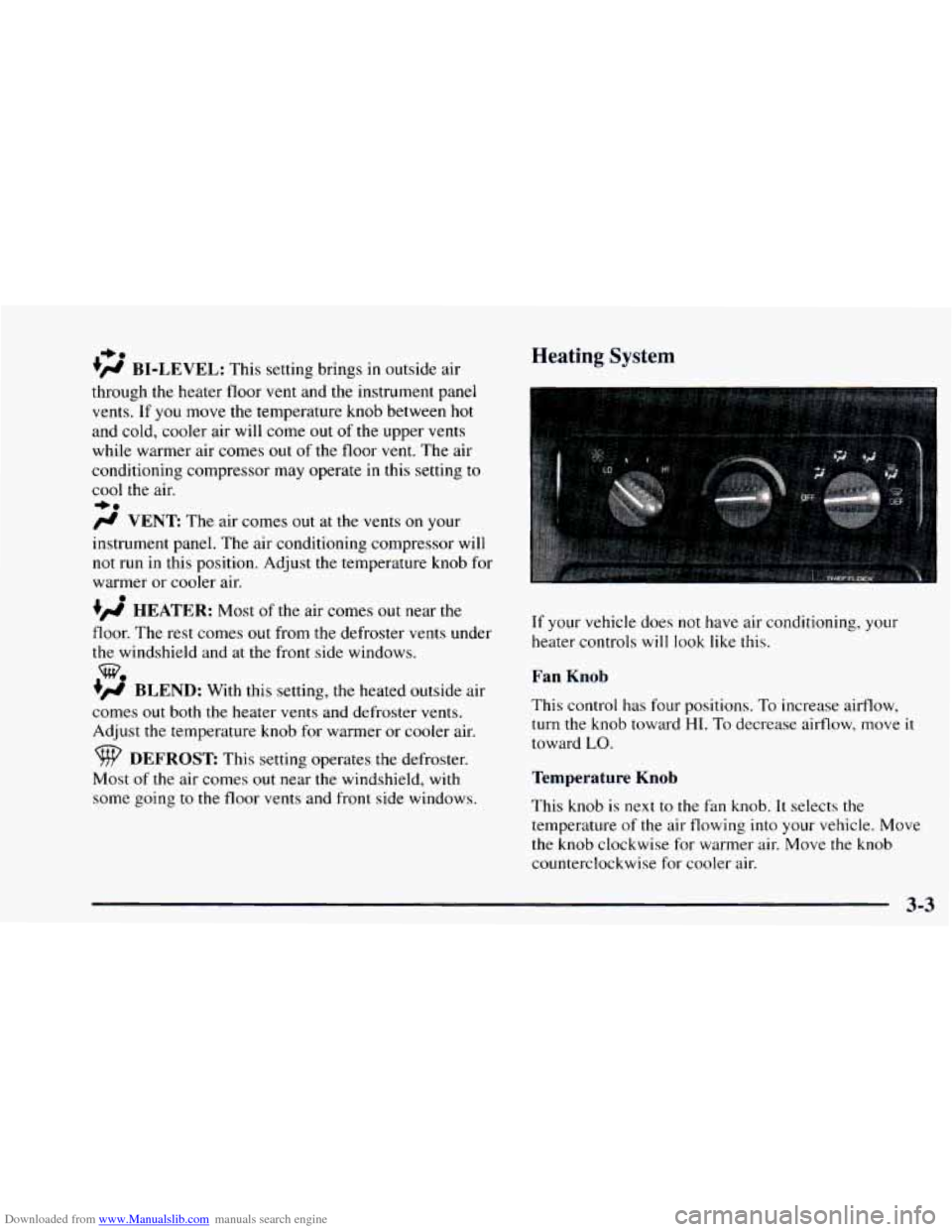
Downloaded from www.Manualslib.com manuals search engine +.
+# BI-LEVEL: This setting brings in outside air Heating System
through the heater floor vent and the instrument panel
vents. If
you move the temperature knob between hot
and cold, cooler air will come out of the upper vents
while warmer air comes out
of the floor vent. The air
conditioning compressor may operate in this setting
to
cool the air.
+e
/J VENT: The air comes out at the vents on your
instrument panel. The air conditioning compressor will
not run in this position. Adjust the temperature knob for
warmer or cooler air.
+’ HEATER: Most of the air comes out near the
floor. The rest comes
out from the defroster vents under
the windshield and at the front side windows.
we
+’ BLEND: With this setting, the heated outside air
comes out both
the heater vents and defroster vents.
Adjust the temperature knob for warmer or cooler air.
0
DEFROST This setting operates the defroster.
Most
of the air comes out near the windshield, with
some going to the floor vents and front side windows.
If your vehicle does not have air conditioning, your
heater controls will
look like this.
Fan Knob
This control has four positions. To increase airflow,
turn the knob toward
HI. To decrease airflow, move it
toward LO.
Temperature Knob
This knob is next to the fan knob. It selects the
temperature of the air flowing into your vehicle. Move
the knob clockwise for warmer air. Move the knob
counterclockwise
for cooler air.
3-3
Page 150 of 404
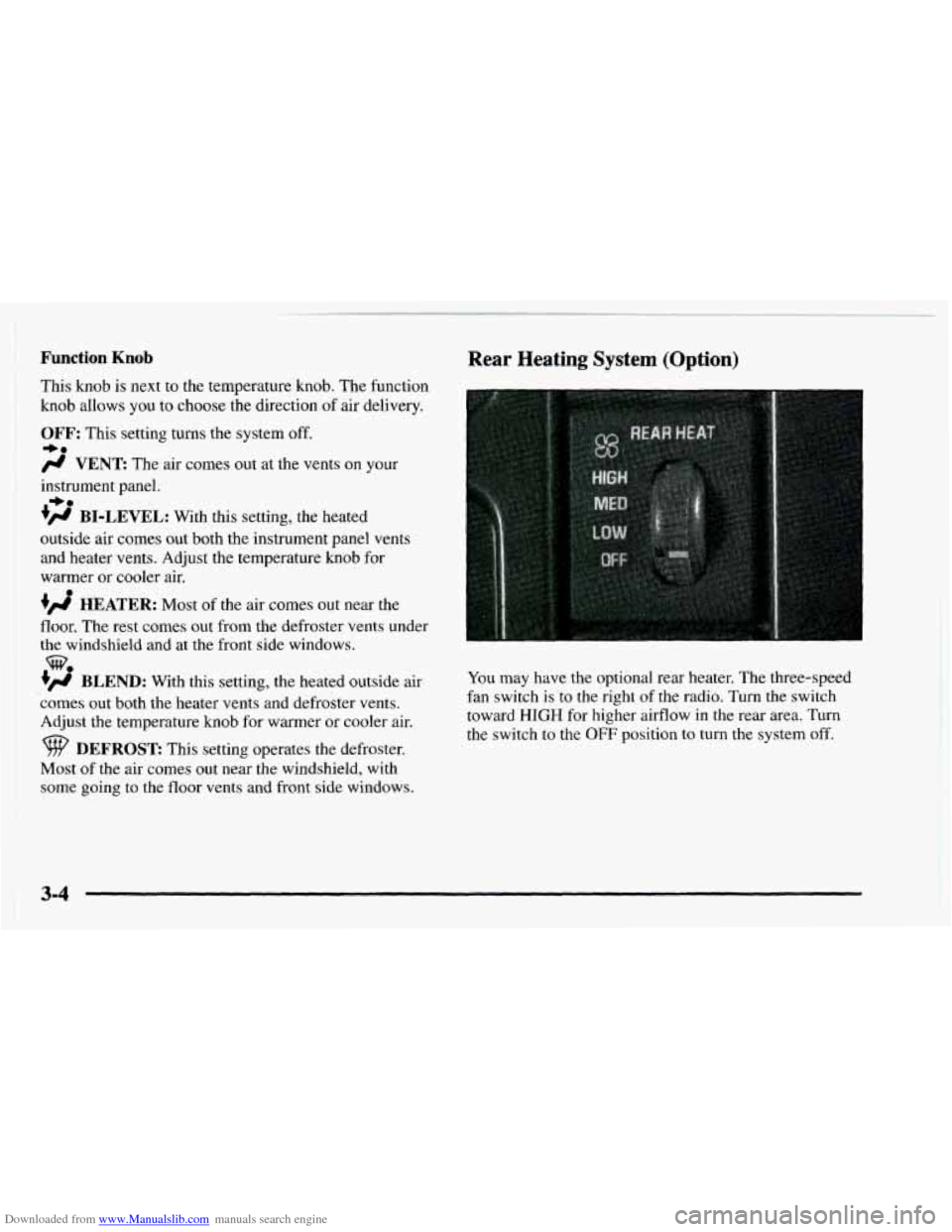
Downloaded from www.Manualslib.com manuals search engine Function Knob
This knob is next to the temperature knob. The function
knob allows you to choose the direction of air delivery.
OFF: This setting turns the system off.
/J VENT The air comes out at the vents on your
-0
instrument panel.
+fl BI-LEVEL: With this setting, the heated
-bo
outside air comes out both the instrument panel vents
and heater vents. Adjust the temperature knob for
warmer or cooler air.
4’ HEATER: Most of the air comes out near the
floor. The rest comes out from the defroster vents under
the windshield and at the front side windows.
+# BLEND: With this setting, the heated outside air
comes out both the heater vents and defroster vents.
Adjust the temperature knob for warmer or cooler air.
9 DEFROST This setting operates the defroster.
Most of the air comes
out near the windshield, with
some going
to the floor vents and front side windows.
@70
Rear Heating System (Option)
You may have the optional rear heater. The three-speed
fan switch is
to the right of the radio. Turn the switch
toward
HIGH for higher airflow in the rear area. Turn
the switch to the
OFF position to turn the system off.
3-4